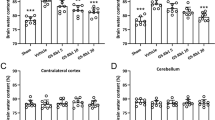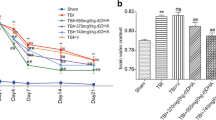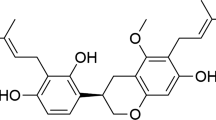Abstract
Traumatic brain injury (TBI) is a leading cause of death and disability worldwide. (-)-Epigallocatechin-3-gallate (EGCG) has shown robust neuroprotective effects on various brain injury models in rodents. Herein, we aimed to investigate if EGCG protects against TBI and unravel the underlying mechanisms. A total of 102 mice were used for this study. TBI was induced by controlled cortical impact (CCI). EGCG was given immediately after TBI injury. Neurological functions were accessed by corner test, paw placement, modified neurological severity score, rotarod test, and Morris water maze test. AMPK inhibitor and AMPKα1-knockout mice were used to further study the signaling pathways involved in the observed effects. Our results show that EGCG significantly ameliorated CCI-induced neurological impairment, including spatial learning and memory. EGCG suppressed CCI-induced inflammation and oxidative stress. Furthermore, EGCG downregulated the phosphorylation of IKKα/β, IκBα, and nuclear translocation of NF-κB p65; upregulated AMPK phosphorylation; and altered corresponding changes in the phosphorylation of the downstream target’s ribosomal protein S6, AS160, and CaMKKß. Our data demonstrate that EGCG protects against CCI-induced TBI through the activation of the AMPK pathway in mice, suggesting that EGCG might be a promising therapeutic intervention preventing locomotor and cognitive impairments after TBI.







Similar content being viewed by others
References
Abdul-Muneer PM, Chandra N, Haorah J (2015) Interactions of oxidative stress and neurovascular inflammation in the pathogenesis of traumatic brain injury. Mol Neurobiol 51:966–979. https://doi.org/10.1007/s12035-014-8752-3
Baldwin AS Jr (1996) The NF-kappa B and I kappa B proteins: new discoveries and insights. Annu Rev Immunol 14:649–683. https://doi.org/10.1146/annurev.immunol.14.1.649
Bowie A, O'Neill LA (2000) Oxidative stress and nuclear factor-kappaB activation: a reassessment of the evidence in the light of recent discoveries. Biochem Pharmacol 59:13–23
Briones TL, Woods J, Rogozinska M (2013) Decreased neuroinflammation and increased brain energy homeostasis following environmental enrichment after mild TBI is associated with improvement in cognitive function. Acta Neuropathol Commun:1
Chu C, Deng J, Man Y, Qu Y (2017) Green tea extracts epigallocatechin-3-gallate for different treatments. Biomed Res Int 2017:5615647. https://doi.org/10.1155/2017/5615647
Ding L, Gao X, Hu J, Yu S (2018) (-)Epigallocatechin3gallate attenuates anesthesiainduced memory deficit in young mice via modulation of nitric oxide expression. Mol Med Rep 18:4813–4820. https://doi.org/10.3892/mmr.2018.9548
Ehrnhoefer DE et al (2008) EGCG redirects amyloidogenic polypeptides into unstructured, off-pathway oligomers. Nat Struct Mol Biol 15:558–566. https://doi.org/10.1038/nsmb.1437
Ge R, Zhu Y, Diao Y, Tao L, Yuan W, Xiong XC (2013) Anti-edema effect of epigallocatechin gallate on spinal cord injury in rats. Brain Res 1527:40–46. https://doi.org/10.1016/j.brainres.2013.06.009
Harun-Or-Rashid M, Inman DM (2018) Reduced AMPK activation and increased HCAR activation drive anti-inflammatory response and neuroprotection in glaucoma. J Neuroinflammation 15:313. https://doi.org/10.1186/s12974-018-1346-7
Hill JL, Kobori N, Zhao J, Rozas NS, Hylin MJ, Moore AN, Dash PK (2016) Traumatic brain injury decreases AMP-activated protein kinase activity and pharmacological enhancement of its activity improves cognitive outcome. J Neurochem 139:106–119. https://doi.org/10.1111/jnc.13726
Ide K, Matsuoka N, Yamada H, Furushima D, Kawakami K (2018) Effects of tea catechins on Alzheimer’s disease: recent updates and perspectives. Molecules:23. https://doi.org/10.3390/molecules23092357
Ikeda I (2008) Multifunctional effects of green tea catechins on prevention of the metabolic syndrome. Asia Pac J Clin Nutr 17(Suppl 1):273–274
Itoh T, Imano M, Nishida S, Tsubaki M, Mizuguchi N, Hashimoto S, Ito A, Satou T (2012) (−)-Epigallocatechin-3-gallate increases the number of neural stem cells around the damaged area after rat traumatic brain injury. J Neural Transm (Vienna) 119:877–890. https://doi.org/10.1007/s00702-011-0764-9
Jalloh I, Carpenter KL, Helmy A, Carpenter TA, Menon DK, Hutchinson PJ (2015) Glucose metabolism following human traumatic brain injury: methods of assessment and pathophysiological findings. Metab Brain Dis 30:615–632. https://doi.org/10.1007/s11011-014-9628-y
Jayakumar AR, Tong XY, Ruiz-Cordero R, Bregy A, Bethea JR, Bramlett HM, Norenberg MD (2014) Activation of NF-kappaB mediates astrocyte swelling and brain edema in traumatic brain injury. J Neurotrauma 31:1249–1257. https://doi.org/10.1089/neu.2013.3169
Jha RM, Kochanek PM, Simard JM (2019) Pathophysiology and treatment of cerebral edema in traumatic brain injury. Neuropharmacology 145:230–246. https://doi.org/10.1016/j.neuropharm.2018.08.004
Kaur P, Sharma S (2018) Recent advances in pathophysiology of traumatic brain injury. Curr Neuropharmacol 16:1224–1238. https://doi.org/10.2174/1570159X15666170613083606
Khan M, Shunmugavel A, Dhammu TS, Khan H, Singh I, Singh AK (2018) Combined treatment with GSNO and CAPE accelerates functional recovery via additive antioxidant activities in a mouse model of TBI. J Neurosci Res 96:1900–1913. https://doi.org/10.1002/jnr.24279
Kondo T, Ohta T, Igura K, Hara Y, Kaji K (2002) Tea catechins inhibit angiogenesis in vitro, measured by human endothelial cell growth, migration and tube formation, through inhibition of VEGF receptor binding. Cancer Lett 180:139–144
Krishan S, Richardson DR, Sahni S (2015) Adenosine monophosphate-activated kinase and its key role in catabolism: structure, regulation, biological activity, and pharmacological activation. Mol Pharmacol 87:363–377. https://doi.org/10.1124/mol.114.095810
Lecumberri E, Dupertuis YM, Miralbell R, Pichard C (2013) Green tea polyphenol epigallocatechin-3-gallate (EGCG) as adjuvant in cancer therapy. Clin Nutr 32:894–903. https://doi.org/10.1016/j.clnu.2013.03.008
Leea S, Suhb S, Kimc S (2000) Protective effects of the green tea polyphenol (−)-epigallocatechin gallate against hippocampal neuronal damage after transient global ischemia in gerbils.Pdf. Neurosci Lett 287:191–194
Ley EJ, Clond MA, Bukur M, Park R, Chervonski M, Dagliyan G, Margulies DR, Lyden PD, Conti PS, Salim A (2012) Beta-adrenergic receptor inhibition affects cerebral glucose metabolism, motor performance, and inflammatory response after traumatic brain injury. J Trauma Acute Care Surg 73:33–40. https://doi.org/10.1097/TA.0b013e31825a769b
Li F et al (2018) Perspectives on the recent developments with green tea polyphenols in drug discovery. Expert Opin Drug Discov 13:643–660. https://doi.org/10.1080/17460441.2018.1465923
Liu YL et al (2018a) Adjudin attenuates cerebral edema and improves neurological function in mice with experimental traumatic brain injury. J Neurotrauma 35:2850–2860. https://doi.org/10.1089/neu.2017.5397
Liu ZM et al (2018b) RIP3 deficiency protects against traumatic brain injury (TBI) through suppressing oxidative stress, inflammation and apoptosis: dependent on AMPK pathway. Biochem Biophys Res Commun 499:112–119. https://doi.org/10.1016/j.bbrc.2018.02.150
Loane DJ, Faden AI (2010) Neuroprotection for traumatic brain injury: translational challenges and emerging therapeutic strategies. Trends Pharmacol Sci 31:596–604. https://doi.org/10.1016/j.tips.2010.09.005
Maas A, Menon D, Adelson P et al (2017) Traumatic brain injury: integrated approaches to improve prevention, clinical care, and research. Lancet Neurol 16:987–1048. https://doi.org/10.1016/S1474-4422(17)30371-X
Mancini SJ et al (2017) Activation of AMP-activated protein kinase rapidly suppresses multiple pro-inflammatory pathways in adipocytes including IL-1 receptor-associated kinase-4 phosphorylation. Mol Cell Endocrinol 440:44–56. https://doi.org/10.1016/j.mce.2016.11.010
Mendez MF (2017) What is the relationship of traumatic brain injury to dementia? J Alzheimers Dis 57:667–681. https://doi.org/10.3233/JAD-161002
Meng Q, Velalar CN, Ruan R (2008) Regulating the age-related oxidative damage, mitochondrial integrity, and antioxidative enzyme activity in Fischer 344 rats by supplementation of the antioxidant epigallocatechin-3-gallate. Rejuvenation Res 11:649–660. https://doi.org/10.1089/rej.2007.0645
Michinaga S, Koyama Y (2015) Pathogenesis of brain edema and investigation into anti-edema drugs. Int J Mol Sci 16:9949–9975. https://doi.org/10.3390/ijms16059949
Nagai K, Jiang MH, Hada J, Nagata T, Yajima Y, Yamamoto S, Nishizaki T (2002) (−)-Epigallocatechin gallate protects against NO stress-induced neuronal damage after ischemia by acting as an anti-oxidant. Brain Res 956:319–322
Osier ND, Dixon CE (2016) The controlled cortical impact model: applications, Considerations for researchers, and future directions. Front Neurol 7:134. https://doi.org/10.3389/fneur.2016.00134
Pearn ML et al (2017) Pathophysiology associated with traumatic brain injury: current treatments and potential novel therapeutics cell. Mol Neurobiol 37:571–585. https://doi.org/10.1007/s10571-016-0400-1
Pushkarna A, Bhatoe HS, Sudambrekar SM (2010) Head injuries. Med J Armed Forces India 66:321–324. https://doi.org/10.1016/S0377-1237(10)80008-5
Rabinovitch RC et al (2017) AMPK maintains cellular metabolic homeostasis through regulation of mitochondrial reactive oxygen species. Cell Rep 21:1–9. https://doi.org/10.1016/j.celrep.2017.09.026
Romine J, Gao X, Chen J (2014) Controlled cortical impact model for traumatic brain injury. J Vis Exp:e51781. https://doi.org/10.3791/51781
Salminen A, Hyttinen JM, Kaarniranta K (2011) AMP-activated protein kinase inhibits NF-kappaB signaling and inflammation: impact on healthspan and lifespan. J Mol Med (Berl) 89:667–676. https://doi.org/10.1007/s00109-011-0748-0
Scheff SW, Ansari MA (2017) Natural Compounds as a therapeutic intervention following traumatic brain injury: the role of phytochemicals. J Neurotrauma 34:1491–1510. https://doi.org/10.1089/neu.2016.4718
Stapleton D, Mitchelhill KI, Gao G, Widmer J, Michell BJ, Teh T, House CM, Fernandez CS, Cox T, Witters LA, Kemp BE (1996) Mammalian AMP-activated protein kinase subfamily. J Biol Chem 271:611–614. https://doi.org/10.1074/jbc.271.2.611
Tak PP, Firestein GS (2001) NF-kappaB: a key role in inflammatory diseases. J Clin Invest 107:7–11. https://doi.org/10.1172/JCI11830
Tang FY, Nguyen N, Meydani M (2003) Green tea catechins inhibit VEGF-induced angiogenesis in vitro through suppression of VE-cadherin phosphorylation and inactivation of Akt molecule. Int J Cancer 106:871–878. https://doi.org/10.1002/ijc.11325
Tedeschi E, Menegazzi M, Yao Y, Suzuki H, Forstermann U, Kleinert H (2004) Green tea inhibits human inducible nitric-oxide synthase expression by down-regulating signal transducer and activator of transcription-1alpha activation. Mol Pharmacol 65:111–120. https://doi.org/10.1124/mol.65.1.111
Wang ZF, Wang J, Zhang HY, Tang XC (2008) Huperzine A exhibits anti-inflammatory and neuroprotective effects in a rat model of transient focal cerebral ischemia. J Neurochem 106:1594–1603. https://doi.org/10.1111/j.1471-4159.2008.05504.x
Xiong Y, Mahmood A, Chopp M (2013) Animal models of traumatic brain injury. Nat Rev Neurosci 14:128–142. https://doi.org/10.1038/nrn3407
Yang L, Guo Y, Wen D, Yang L, Chen Y, Zhang G, Fan Z (2016) Bone fracture enhances trauma brain injury. Scand J Immunol 83:26–32. https://doi.org/10.1111/sji.12393
Zhang L, Schallert T, Zhang ZG, Jiang Q, Arniego P, Li Q, Lu M, Chopp M (2002) A test for detecting long-term sensorimotor dysfunction in the mouse after focal cerebral ischemia. J Neurosci Methods 117:207–214
Zhang B, Wang B, Cao S, Wang Y (2015) Epigallocatechin-3-gallate (EGCG) attenuates traumatic brain injury by inhibition of edema formation and oxidative stress. Korean J Physiol Pharmacol 19:491–497. https://doi.org/10.4196/kjpp.2015.19.6.491
Author information
Authors and Affiliations
Contributions
Yinyin Wu and Jing Cui conceptualized the study and conducted the literature review for all databases. Jing Cui performed all statistical analyses. Yinyin Wu drafted the paper.
Corresponding author
Ethics declarations
All animal procedures were in accordance with the Guide for the Care and Use of Laboratory Animals (8th edition, NIH) and approved by The Second People’s Hospital of Hefei City.
Conflict of interest
The authors declare that they have no conflict of interest.
Additional information
Publisher’s note
Springer Nature remains neutral with regard to jurisdictional claims in published maps and institutional affiliations.
Rights and permissions
About this article
Cite this article
Wu, Y., Cui, J. (-)-Epigallocatechin-3-gallate provides neuroprotection via AMPK activation against traumatic brain injury in a mouse model. Naunyn-Schmiedeberg's Arch Pharmacol 393, 2209–2220 (2020). https://doi.org/10.1007/s00210-020-01841-1
Received:
Accepted:
Published:
Issue Date:
DOI: https://doi.org/10.1007/s00210-020-01841-1




